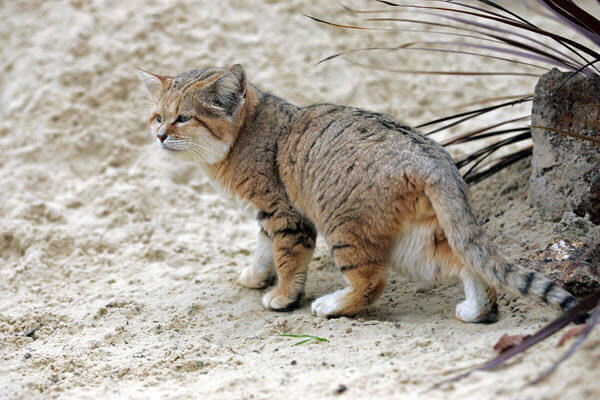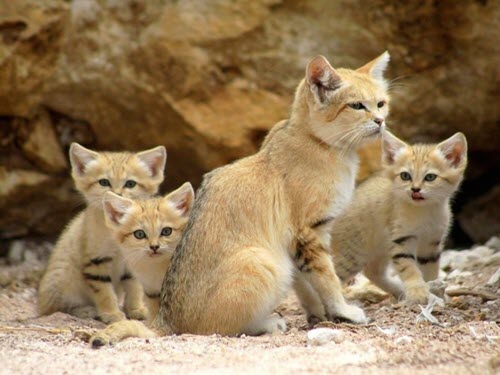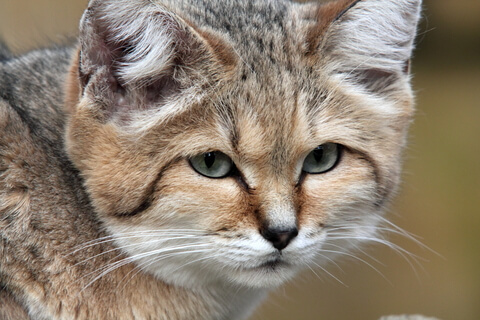The sand cat, also called the sand dune cat, is one of the smallest of all the wild cats. They can be found in the deserts of northern Africa as well as Southwest and Central Asia. These small wild cats have adapted to the desert environment including both sandy and rocky desert. They are considered non-aggressive and even docile, which has made them a target for illegal pet traders.
The cats can live quite a distance from water, and they can tolerate both extremely hot and cold weather. They are considered a rare species. The subspecies Felis margarita scheffeli, a sand cat that lives in Pakistan, is listed as Endangered.
There are very few official records and studies of the sand cat. In 1994, the IUCN first listed the cat as “insufficiently known”. The cat was classified as “near threatened” in 2002.
Similar to most felines, the sand cat is a solitary animal that communicates with others only by scent trails and claw marks. They run quickly with their bellies to the ground and cross great distances, 3 to 6 miles in one night.
Scientific Name: Felis margarita
Conservation Status: Near Threatened
Subspecies:
- F. m. margarita (North Africa)
- F. m. thinobia (West and Central Africa)
Sand cat history
All cats are members of the Felidae family. There are 8 lineages (lines) of Felidae cats: Panthera, Bay Cat, Caracal, Leopardus, Lynx, Puma, Leopard Cat and Felis. The sand cat is a member of the Felis lineage. The common ancestor of all members of the Felis lineage lived between 4 and 2 million years ago. The jungle cat was the first species that evolved from this ancestor, followed by the black-footed cat and then the sand cat. It is believed the sand cat migrated to the Africa during periods with the sea level was low.
Interesting sand cat facts
-
- The sand cat is the smallest wild cat.
- The visible part of the cat’s ear is extremely large, which helps protect the ear from the sand.
- Sand cats are exceptional diggers
More about the sand cat
Physical characteristics
The sand cat’s fur is the color of pale sand, as their name suggests, and they are a small, stocky cat with short legs. At the top of their legs they often have two dark brown rings that circle fully around. They have thick fur covering the underside of their paws to protect from the extreme shifts in temperature. The sand cat also has a darkish streak that runs down its face from the eye to the cheek.
Where you can find the sand cat
Sand cats can be found in throughout the Arabian Peninsula, in central and southwestern Asia and Africa.
Hunting and prey (diet)
The sand cat will usually remain hidden during the day, either in a burrow or under rocks and shrubs, and hunt at night. The sand cat’s preferred prey are rodents and hares, but the cats will also hunt small birds, lizards, and insects, as well as gerbils, sand voles, and hares. Sand cats will live in areas with enough vegetation for their prey. They can even dig out prey that has buried itself. Sand cats are able to live far away from water. They will satisfy their moisture needs from their prey (similar to the black-footed cat) but do drink if water is readily available.
Reproduction and lifespan
The female gestation period for a sand cat is 59 to 66 days and the average litter size is between 3 and 5 kittens. Although they may have 2 litters per year (usually in captivity), it is more common that they will have only one. When seeking a mate, sand cat will make loud, high-pitched barking sounds. The reproduction cycle for cats in the Sahara u sually begins in January and ends in April. Cats in Pakistan only have a breeding period that lasts two months, from September to October. Most young sand cats will be on their own by the time they are 8 months old.
sually begins in January and ends in April. Cats in Pakistan only have a breeding period that lasts two months, from September to October. Most young sand cats will be on their own by the time they are 8 months old.
The life span of Sand Cats in the wild has not been documented but it has been noted that they can live up to 13 years in captivity. Only 40% of the cats in captivity lived to day 30 due to the maternal neglect of first-time mothers.
Conservation issues
Habitat degradation is one of the biggest threat to the sand cat, along with the loss of prey. They also are often killed in fox or jackal traps, and captured for illegal pet trade. It is illegal to hunt the sand cat in several countries, including Israel, Iran, Niger, Tunisia, Pakistan, Mauritania, Niger and Algeria.

